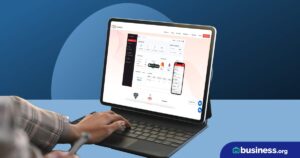💸 See if your business qualifies for a tax credit worth up to $26k per employee. 📞 Call Now: 855-979-9597
Ordoro vs Fishbowl Inventory 2023
Data as of 2/16/23. Offers and availability may vary by location and are subject to change.
We are committed to sharing unbiased reviews. Some of the links on our site are from our partners who compensate us. Read our editorial guidelines and advertising disclosure.
Ordoro has fantastic features that run the gamut from dropshipping to analytics. However, Fishbowl offers manufacturing features that are perfect for larger industries, and its native integration with QuickBooks is a huge plus.
Both Ordoro and Fishbowl are top-notch inventory management systems, so which one is right for your business?
Ordoro vs Fishbowl Table of Contents
- : Tie
- : Fishbowl
- : Tie
- : Tie
Top feature comparison
Ordoro and Fishbowl seem evenly matched as inventory management solutions, and they offer similar features—from selling to storing inventory. Both platforms are more expensive than other inventory management software, but how do they compare to each other?
Compare Ordoro and Fishbowl Inventory top features
Data as of 2/16/23. Offers and availability may vary by location and are subject to change.
* With integration
Ordoro has more native inventory features, but Fishbowl has the upper hand on manufacturing features. So where do they actually differ?
Well, Fishbowl Inventory offers a one-time fee while Ordoro is per month—over the course of one year, you would spend more on Ordoro than Fishbowl. Ordoro is built for multiple orders and sales channels while Fishbowl Inventory is specifically for warehouse or manufacturing needs. If you just want a basic inventory management platform, then both Ordoro and Fishbowl Inventory are not for you.
However, both platforms offer features beyond inventory management like dropshipping in Ordoro and manufacturing control in Fishbowl Inventory. So, if you’re business is looking to expand into either realm, then Ordoro and Fishbowl could be worthwhile investments.
By signing up I agree to the Terms of Use and Privacy Policy.
Ordoro plans and pricing for 2023
Data as of 2/16/23. Offers and availability may vary by location and are subject to change.
º Some additional fees may apply
Although the Express plan is super affordable for small businesses, it does not include inventory management capabilities. The Pro plan, at $499/mo., is one of the more expensive inventory management systems out there.
Fishbowl Inventory plans and pricing for 2023
Data as of 02/16/23. Offers and availability may vary by location and are subject to change.
Fishbowl starts at a one-time fee of $4,395, which makes it more affordable in the long term, but if you want support and updates, you’ll need to renew each year.
The most affordable plan for your business may depend on which features you want and the level of customer support you need. Because of that, Ordoro and Fishbowl Inventory tie in the affordability category.
Best for manufacturing: Fishbowl Inventory
With its separate software plan for manufacturing, Fishbowl is the go-to inventory management software for businesses that also manufacture products. Why? Because its software includes work orders, bills of materials, barcode scanning, and easy tracking of products and materials. This sort of control over the manufacturing process combined with Fishbowl’s regular inventory management system is unheard of. You really can’t go wrong here.
Plus, with its native QuickBooks integration, you can easily calculate the cost of materials and products while in manufacturing. In fact, its integrations allow you to successfully move manufactured goods onto the sales floor with one click. Ecommerce integrations connect with major platforms (see more below) and Electronic Data Interchange (EDI) integrations automatically transfer any sales order to a purchase order for manufacturing.
Ordoro, on the other hand, has many of the basic integrations you would expect. In fact, many of the integrations are the same as Fishbowl. But Ordoro’s system just can’t measure up.
Why is Fishbowl the best? Because all of these systems work together. It’s uncommon to find a system that combines these processes into one, creating a seamless manufacturing and inventory management arrangement that works for your business—from the start of creation to the final sale.
Best warehouse features: Tie
Although Fishbowl has a whole separate inventory management module designed for warehousing products, Fishbowl Inventory and Ordoro tie on warehouse features. The main reason is that they classify warehouses differently, and so—again—Fishbowl and Ordoro are designed for different business owners.
Ordoro and Fishbowl provide complementary features for specific business types without much overlap, which is why they are tied. If you are looking for large-scale warehouse inventory management, then Fishbowl is the choice for you. But if you store your inventory anywhere and across multiple locations, then you can’t go wrong with Ordoro. Think about what kind of warehouse you are going to need, and then pick the one that fits your business.
Best for selling: Ordoro
From kitting and dropshipping to marketplace and shopping cart integrations, Ordoro is designed for selling. It integrates with all the major ecommerce sites (we’ll get into integrations more below) and is primarily designed for order management and shipping—so you know its sales features are top notch.
Ordoro offers multi-carrier shipping, discounted USPS rates, and barcode scanning right off the bat. The software works with dropshipping suppliers by making it easy to sell products from varied vendors.
Although Fishbowl also has ecommerce integrations—its website notes 13 ecommerce integrations including Shopify, WooCommerce, Amazon, and eBay—Ordoro has the edge on selling platforms with a combined 18 shopping carts and marketplaces available.
But more than that, the Ordoro system is designed for selling and shipping products. If you’re looking to sell online and reach customers around the globe, Ordoro is the right option for you.
Best integrations: Tie
As we talked about in the selling section, both Ordoro and Fishbowl Inventory have a long list of integrations. Ordoro has more integrations, but Fishbowl has powerful integrations, so we're calling a tie here. While Ordoro is ready to integrate your business with everything from point-of-sale systems to fulfillment services, Fishbowl’s native QuickBooks integration is a tool unlike anything else in the inventory management market.
Ordoro’s integrations get products to customers in the easiest way possible. You can use the shopping cart and marketplace integrations to sell your products online. Then, point-of-sale partners ensure you receive payment, and shipping carriers deliver the product. So in addition to the ecommerce integrations above, you also have:
- 3PL Central
- Canada Post
- DHL
- FedEx
- Fulfillment by Amazon
- QuickBooks
- Shopify POS
- Square
- UPS
- USPS
Fishbowl Inventory has a native integration with QuickBooks that is one of its big selling points. While Ordoro does have a QuickBooks integration, Fishbowl is quite literally built for QuickBooks integration. Pairing Fishbowl and QuickBooks allows you to play to both systems’ strengths, combining QuickBooks’ accounting with Fishbowl’s inventory management features. This matters because Fishbowl is designed to work in concert with QuickBooks through updates and new features. It’s rare to find a brand that does that, and it immediately elevates Fishbowl beyond normal inventory management status. In addition to QuickBooks, Fishbowl integrates with:
- Amazon
- 3dcart
- BigCommerce
- DHL
- eBay
- FedEx
- Magento
- onTrac
- Salesforce
- ShipRush
- ShipStation
- Shopify
- Square
- SPS Commerce
- UPS
- USPS
- Walmart
- WooCommerce
- X Cart
- Xero
- Zoho
Which one has the best integrations? Both offer great integrations, although Ordoro is geared more toward selling while Fishbowl is geared more toward accounting. So, determining which one is best depends on what your business needs.
The takeaway
At the end of the day, Ordoro and Fishbowl inventory management systems work best for different kinds of businesses. If you’re running a large business with multiple warehouses or focusing on manufacturing, then Fishbowl is the choice for you. But if you’re looking at sales channels and selling inventory, then you can’t go wrong with Ordoro.
Both Ordoro and Fishbowl offer demos so you can see how their software would work for you before committing to a plan.
Still looking for the right inventory management software for your business? Check out our top choices for 2023.
Related content
Inventory management FAQ
Efficient inventory management allows you to track your products from supplier to your business and to each customer. It can also include accounting, customer relationship management, and timekeeping for employees. But most importantly, it’s ensuring you have inventory on hand to fulfill orders, ship to customers, and keep them coming back for more.
Product inventory management is understanding stock levels and where you are storing products—in a warehouse, with a supplier, or in a retail location. Inventory management software helps you track products across locations so that you know where the items are at all times. When you’re selling products, knowing what’s in your inventory is the most important thing. Product inventory management ensures that you know where your products are in the supply chain and how soon you can sell products to customers.
To manage inventory, focus on fulfilling customer needs. So, you could order items in advance (push inventory), special order items (pull inventory), or keep as few items on hand (just in time inventory) for a customer. Once you have inventory on hand, pay attention to your inventory count (what’s in stock) and your inventory turnover (what you’re selling).
You can manage your inventory by reordering products when you need them or tracking your inventory levels across quarters to see how things are selling. And, of course, you want to balance your books too. Most businesses rely on inventory management software to help with these tasks.
We can help you find out what your inventory management needs are and determine which inventory management style works for you. Check out our inventory page for product reviews, lists, and everything else you need to know about inventory management.
The four main types of inventory are raw materials; work-in-process items; finished goods; and maintenance, repair, and operations (MRO) goods. Of course, there are other categories that include other types of inventory—like transit inventory that’s being transported to the buyer. But those four categories cover most inventory types that business owners are going to deal with.
That depends on what you need. We think Zoho Inventory is the best for small businesses, Ordoro is best for ecommerce, and Cin7 is the best enterprise resource planning (ERP) solution. If you’re on a budget, you can’t go wrong with either Zoho or inFlow Inventory. And restaurants need something special which Upserve provides. We’ve covered all of them and more in our ranking of best inventory management software.
But of course, each business is unique and has different needs. We recommend doing free trials of different inventory management systems to see which ones work best for you.
Methodology
We compared Ordoro and Fishbowl Inventory based on many factors, including pricing and plans, integrations, features, and ease of use. Our comparison looks at how well each inventory management system performs in various challenges. The results are subjective and may vary for different businesses.
Disclaimer
At Business.org, our research is meant to offer general product and service recommendations. We don't guarantee that our suggestions will work best for each individual or business, so consider your unique needs when choosing products and services.








